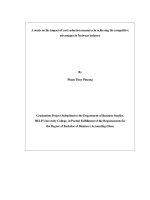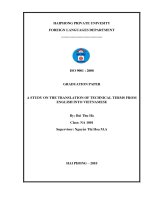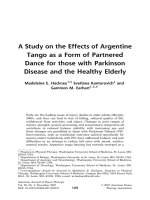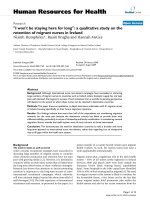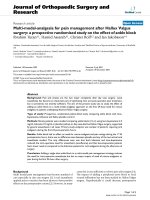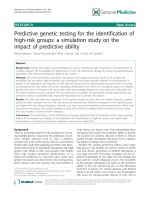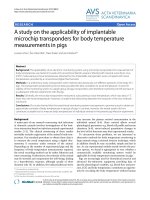Study on the technical measures for the cultivation of ngoc linh ginseng (panax vietnamensis) in vitro seedling in nursery
Bạn đang xem bản rút gọn của tài liệu. Xem và tải ngay bản đầy đủ của tài liệu tại đây (3.23 MB, 76 trang )
VIENAM NATIONAL UNIVERSITY OF AGRICULTURE
FACULTY OF AGRONOMY
UNDERGRADUATE THESIS
TOPIC: STUDY ON THE TECHNICAL MEASURES
FOR THE CULTIVATION OF NGOC LINH
GINSENG (PANAX VIETNAMENSIS) IN VITRO
SEEDLING IN NURSERY
Student
:
Vu Thi Huyen Trang
Student code
:
611646
Supervisor
:
Dr. Thieu Thi Phong Thu
Class :
K61-KHCTT
Assoc.Prof.Dr. Le Hung Linh
Department :
Crop Science
HA NOI -2021
ACKNOWLEDGE
There is an undeniable fact that, beside the own effort, there are no
successes that are not associated with support or assistance whether more or
less, directly or indirectly by others. This thesis would not have been possible if
I did not have support of many individuals and organizations. Therefore, I would
like to extend my sincere gratitude to all of them.
First of all, I would like to express my thankful to the lecturer in Faculty
of Agronomy of Vietnam National University of Agriculture with their
knowledge and dedication to convey valuable knowledge to me during the time
of studying at university.
Secondly, I am using this opportunity to express my deep and sincere
gratitude to Dr. Thieu Thi Phong Thu and Associate prof. Dr. Le Hung Linh
who in site of being extraordinarily busy with her duties, took time out to hear,
guide and keep me on the correct path. It was a great privilege and honor to
work and study under their guidance
I am also grateful to Department of Molecular Biology - Institute of
Agricultural Genetics, Experimental station in Van Giang - Hung Yen and
technical support in the implementation. I would not forget to express my
special thanks to Dr. Khuat Thi Mai Luong and all personnel of Institute.
Without Dr. Khuat Thi Mai Luong and others superior knowledge and
experience, this undergraduate thesis would not like in quality of outcomes, and
thus their guidance and support have been essential.
However, due to limiting my professional knowledge and lacking in
practical experience, the content of the topic can not avoid the deficiencies. I
look forward to receiving recomments from lecturers and all staffs at the
university that make this report complete. Thank you for your consideration.
Hanoi, March …. 2021
i
TABLE OF CONTENTS
ACKNOWLEDGE ....................................................................................................... i
TABLE OF CONTENTS ............................................................................................. ii
LIST OF TABLE ........................................................................................................ iv
LIST OF GRAPH .........................................................................................................v
LIST OF FIGURE ...................................................................................................... vi
LIST OF FIGURE ...................................................................................................... vi
ABSTRACT .............................................................................................................. vii
PART 1: INTRODUCTION .......................................................................................1
1.1. Background ........................................................................................................... 1
1.2. Objectives and requirements ................................................................................. 2
1.2.1. Objectives .......................................................................................................... 2
1.2.2. Requirements ..................................................................................................... 2
PART 2: LITERATURE RVIEW .............................................................................3
2.1. Introduce about Ginseng ....................................................................................... 3
2.2. General introduction to ginseng species of the Panax genus in Vietnam ............... 7
2.3. Introduce about Ngoc Linh ginseng .................................................................... 11
2.3.1. The original of Ngoc Linh ginseng ................................................................... 11
2.3.2. Botanical characteristics, growth and development of Ngoc Linh ginseng,
external requirements of Ngoc Linh ginseng. ............................................................. 13
2.3.3. Natural conditions in the distribution area of Ngoc Linh ginseng Climate
condition
................................................................................................................ 16
2.3.4. The value of Ngoc Linh ginseng ...................................................................... 17
2.4. The state of Ngoc Linh ginseng research and development ................................. 18
2.4.1. Researches on propagation from seeds ............................................................. 19
2.4.2. Researches on in vitro clonal propagation ....................................................... 19
2.5. Researches optimize the growth and development process of Ngoc Linh ginseng. .... 20
2.5.1. The condition of planting and caring for Ngoc Linh ginseng ............................ 20
2.5.2. Research on growing medium Ngoc Linh ginseng ........................................... 21
ii
PART 3. CONTENT AND METHOD OF RESEARCH ........................................ 25
3.1. Research materials .............................................................................................. 25
3.2. Place and time of the research ............................................................................. 27
3.3. Research content ................................................................................................. 27
3.4. Experimental parameters ..................................................................................... 29
3.5. Data processing methods ..................................................................................... 29
PART 4. RESULTS AND DISCUSSION ................................................................ 30
4.1. Research on standardization of in vitro seedlings Ngoc Linh ginseng ................. 30
4.2. Effect of the substrate on the viability and growth of Ngoc Linh ginseng in vitro
seedlings .................................................................................................................... 34
4.2.1. Experiment in laboratory conditions at Van Giang Experimental Station ......... 34
Figure 4. 5: Ngoc Linh ginseng in vitro seedling used in the experiment..................... 35
4.2.2. Experiment in net house conditions at the Experimental station in Sa Pa.......... 37
4.2.3. Experiment in nursery conditions at Sa Pa experimental station ....................... 39
4.3. Effect of plant age on in vitro seedling adaptability in vitro in nursery ................ 42
4.4. Effect of spraying time of AT Chibozin on the growth of in vitro seedlings in the
nursery ....................................................................................................................... 46
4.5. Assessment of pests and diseases of Ngoc Linh ginseng in Sa Pa ........................ 49
PART 5. CONCLUSIONS AND SUGGESTIONS ................................................. 53
5.1. Conclutions ......................................................................................................... 53
5.2. Suggestion .......................................................................................................... 53
REFFERENCE ......................................................................................................... 54
ACTIVE IMAGE ......................................................................................................56
iii
LIST OF TABLE
Table 2.1: Species of ginseng were registered ...............................................................3
Table 2.2: Panax species in the world ...........................................................................6
Table 4.2: Effects of substrate on in vitro seedling adaptability in the net house
conditions ................................................................................................................... 38
Table 4.3: Table 4. 3 Effects of substrate on in vitro seedling adaptability in nursery
conditions ................................................................................................................... 40
Table 4.4: Effect of plant age on in vitro seedling adaptability in nursery ................... 44
Table 4.5: Effect of spraying time of AT Chibozin on the growth of in vitro seedlings
in the nursery .............................................................................................................. 48
iv
LIST OF GRAPH
Graph 4.1: Describe the survival rate of Ngoc Linh ginseng in vitro seedling planting
in three location .......................................................................................................... 42
Graph 4.2: Effect of plant age on in vitro seedling adaptability in nursery .................. 45
v
LIST OF FIGURE
Figure 2.1: The most commonly of ginseng .................................................................4
Figure 2.2: Distribution of Ginseng species in the world ...............................................5
Figure 2.3: Ngoc Linh ginseng .................................................................................... 15
Figure 3.1: Ngoc Linh ginseng in vitro seedling.......................................................... 25
Figure 3.2: Perlite rock and Vermiculite of Namix company ......................................26
Figure 4.1: Ngoc Linh ginseng tubers have no morphogenetic differentiation ............. 30
Figure 4.2: The ginseng tubers have not split clearly between buds and node ................... 32
Figure 4.3: Ngoc Linh ginseng tuber is morphogenetic differentiation ........................ 32
Figure 4.4: Ngoc Linh ginseng tuber have morphogenetic differentiation clearly ........ 33
Figure 4.1: Ngoc Linh ginseng in vitro seedling used in the experiment ..................... 35
Figure 4.6: Ngoc Linh ginseng in vitro seedlings in the net house ............................... 37
Figure 4.7: Ngoc Linh ginseng in vitro seedlings in Sapa ........................................... 39
Figure 4.8: Ngoc Linh ginseng in vitro seedlings growth in Sapa ................................ 45
Figure 4.9: Experiment spraying AT Chibozin after 20 days planting ......................... 47
Figure 4.10: Photos of bare slugs harming Ngoc Linh ginseng seedling in Sa Pa ........ 51
Figure 4.11: Image of diseases of Ngoc Linh ginseng seedlings in Sa Pa .................... 52
vi
ABSTRACT
Ngoc Linh ginseng (Panax vietnamensis Ha et Grushv.) is proven to have
high medicinal value, and is classified as the most precious ginseng in the world.
Nowadays, Ngoc Linh ginseng have been overexploited so seed propagation
must be faced many difficulties. This study aimed to choose the suitable
technique to raise the survival rate, the adaptability in the natural environment of
Ngoc Linh in vitro seedling. In this study, Ngoc Linh in vitro seedlings were
used the initial materials to survey the effect of other substrates (humus, perlite
rock, vermiculite mineral organic fertilizers and peat moss), the effect of age
plant ( 1 year old, 1.5 years old and 2 years old) and the effect of time spray
biological products (AT Chibozin) on the adaptive capacity of in vitro seedlings
in the nursery. The result showed that the mixture substrate with forest humus,
vermiculite and perlite rock in the ratio of 2: 3: 1 is suitable for a high survival
rate of over 80%. Seedlings have a high survival rate, strong plants and good
growth and development. The age of plants are appropriate to take the seedlings
to the nursery which ensures good growth and development are plants from over
1.5 years old. Research results on the effect of spraying time of AT Chibozin on
the growth of seedlings in vitro in the nursery, the seedlings have the best
growth and development when spraying 35 days after planting. Throughout the
survey in nursery, Ngoc Linh ginseng grown in Sapa has identified a number of
pest such leaf worms, black cutworms, armyworm, grasshoppers, brown
crickets, bare slugs and maggots in bulb and root; and some diseases as disease
are caused by fungus: Rhizoctonia Solani , ring spot Alternaria alternata or
rust Puccinia sp.. Based on this systematic review, this is the basis for Ngoc
Linh ginseng plant can be acclimatized to the region with similar ecological
conditions to widen the ginseng plant.
vii
PART 1: INTRODUCTION
1.1. Background
Ngoc Linh ginseng is an endemic species in Viet Nam and the world. It
has been known to the scientific name Panax vietnamensis Ha et Grushv. Ngoc
Linh ginseng has been identified as valuable medicinal plants, unique value to
use as well as the value of genetic resources. According to Phung Tuan Giang
from Tho Xuan Duong Oriental Medicine Pharmacy in Hanoi, the stem and root
of Ngoc Linh ginseng contain 52 saponin, which has many new compounds as
majonoside-R2 (type saponin only found in P. vietnamensis), ginsenoside-Rh5
(20-O-Me-G-Rh1), vina-ginsenosid R-25, etc. (Korean ginseng (P. ginseng) has
about 25 types of saponins). Due to many good uses for human health, high
economic value, Ngoc Linh ginseng has been exploited at risk of extinction,
losing rare genetic resources.
In recent years, Ngoc Linh ginseng has been entered in the list of
development and conservation priority species. But, in fact, the production of
propagating Ngoc Linh ginseng is still facing many difficulties as: (1) Did not
take interest in the adequate value and potential of it. The production is still
fragmented, the indiscriminate exploitation of Ngoc Linh ginseng has occurred,
resulting in the exhaustion of variety sources. (2) While the demand for the
Ngoc Linh ginseng variety in our country is huge, it does not have the stable
supply of seedlings in both quantity and quality. The production of seedlings
following traditional methods with effective seed is not high. The reason is that
it takes time to develop into mature plants and flower seeding takes 4-5 years, the
germination rate of seeds is low 50-60%. This is the limiting factor which affected
the successful development of Ngoc Linh ginseng production in Viet Nam.
To respond the pressing needs, the rapid multiplication method using
embryonic cloning technique is already giving high efficiency. This method
allows for the shortest possible time, the large-scale rapid multiplication, high
1
uniformity plants, disease-free and keep the genetic characteristics of the
parents. However, Ngoc Linh ginseng seedlings in vitro need to be trained to
enhance the adaptability in the natural environment with the ability growth and
development well. Thus the theme: "Study on the technical measures for the
cultivation of Ngoc Linh ginseng (Panax vietnamensis) in vitro seedling in
nursery" is necessary and practical significance.
1.2. Objectives and requirements
1.2.1. Objectives
Studying the technical measures for cultivation of Ngoc Linh ginseng
(Panax vietnamensis) in vitro seedling in nursery to choose the suitable technic
to raise the survival rate, the adaptability in the natural environment of seedling.
1.2.2. Requirements
- Evaluate the morphological tubers of Ngoc Linh ginseng which effect
the growth and development of Ngoc Linh ginseng in nuresery.
- Evaluating the effect of types of substrates and probiotics on the
survival rate, the growth rate, and disease rates of Ngoc Linh ginseng seedlings
in vitro at the nursery stage.
- Evaluating the effects of nutritional probiotics and disease probiotics on
the survival rate, the growth and disease rates of Ngoc Linh ginseng seedlings in
vitro at the nursery stage.
2
PART 2: LITERATURE RVIEW
2.1. Introduce about Ginseng
Ginseng belongs to the Araliacaea family, carrots, celery and radishes also
belong to this family. Araliacaea consists of about 700 species of plants, divided
into 70 genus, one of which is the Panax genus. The Panax genus has 5-13
species (Persons và Davis, 2007), but among it only 5 species have been
officially registered (Table 2.1). Panax japonicum has been found naturally
growing in the mountains of Japan since ancient times. The Japanese have
grown Panax ginseng and exported to China and Hong Kong (Persons, 1994).
Panax notoginseng has pharmacological characteristics similar to those of the
two most valuable species (P. quinquefolium and P. ginseng) and it is becoming
increasingly popular as a herb. Panax trifolium is called dwarf ginseng or
ground nut, are founded in American (Persons and Davis, 2007).
Table 2. 1: Species of ginseng were registered
No.
Latin name
Common name
Original
1
Panax ginseng
Asian or Korean ginseng
Siberia, Korea,
China
2
Panax japonicum
3
Panax notoginseng
4
Panax trifolium
Japanese ginseng
Japan
China
Dwarf ginseng, ground
North America
nut
5
Panax quinquefolium
American ginseng
North America,
Canada
(Persons and Davis, 2007)
Ginseng (Panax ginseng C. A. Meyer) is a perennial herbaceous plant
cultivated for its highly valued root in Korea, northeastern China, the northern
United States, and Canada (But et al. 1995). It is traditionally considered one of
3
the most potent medicinal plants. Ginseng plants are known by various names
depending on their origin, cultivation, the food processing method used, and so
on. Many ginseng cultivars are currently valuable commercially. Three major
species are included in ginseng; one is Panax ginseng C. A. Meyer, referred to
as ‘‘oriental ginseng,’’ which is distributed primarily in Asia and East Siberia;
another is P. quinquefolium L., commonly called ‘‘American ginseng;’’ the
other is P. notoginseng (Burkill) F.H. Chen (Sanchi), which is called ‘‘Chinese
ginseng’’ (Chang and But 1986). The species P. ginseng includes several
accessions
and
cultivars: Chunpoong,
Yunpoong,
Jakyung,
Gopoong,
Kumpoong, Sunpoong, Hwangsook, and Sukju. Among these, three cultivars—
Chunpoong, Gopoong, and Kumpoong—are suitable for generating ‘‘red
ginseng’’ (steamed ginseng roots) because they have good root shapes.
Figure 2. 1: The most commonly of ginseng
The Panax genus includes 16-18 species (Sharma and Pandit 2009). The
species composition of the Panax genus (Panax L.) has many changes
depending on the author groups. Until now, the authors quite agreed that the
genus Panax L., Araliaceae in the world has 11 species and 1 variete ( Table
2.2): Ginseng (Panax ginseng C. A. Mey); Panax pseudo-ginseng Wall; Panax
4
notoginseng Chen; American ginseng (Panax quinquefolius L.); Japanese
Ginseng (Panax japonicus C. A. May); Narrow-leaf ginseng (Panax wangianus
S. C. Sun); Panax bipinnatifidus Seem; Panax bipinnatifolius var. angustifolius
(Burk) Wen); Panax stipuleanatus Tsai et Feng; Panax zingiberensis Wu et
Feng; Panax trifoliatus L.; and Vietnamese Ginseng (Panax vietnamensis Ha et
Grushv) (Thuong Dong Nguyen et al., 2007). Based on its geographical or
commercial origin, ginseng is divided into two main things: Panax ginseng
Asian and Panax quinquefolium American. Most of the genus is distributed in
Asia, from East to North Asia to the near Himalayas and there are only three
species in North America (Figure 2.1).
Figure 2. 2: Distribution of Ginseng species in the world
5
Table 2. 2: Panax species in the world
No.
Species name
Common name
Distribution
1
P. ginseng
Korean/Asian ginseng
Eastern Asia
2
P. notoginseng
Sanqi ginseng
SW China
3
P. japonicus var. Major
Pearl ginseng
Japan
4
P. japonicus var.
Narrow leaf
Japan
Angustifolius
pearlginseng
P.japonicus var.
Yu-yeh-shen
Japan
Chiajen-shen
Nepal/ E
5
Bipinnatifidus
6
P. pseudo-ginseng
Himalayas
7
P. zingiberensis
Ginger shaped ginseng
Eastern Asia
8
P. stipuleanatus
Pingbiann Sanqi
Eastern Asia
9
P. vietnamensis
Vietnamese ginseng
Vietnam
10
P. quinquefolius
American ginseng
North America
11
P. trifolius
Dwarf ginseng
NE America
(Source: />In particular, the composition species of Panax genus are valuable as
medicines, some species of this genus are currently grown on a large scale in
many countries, not only within the scope of the Oriental traditional medicine
but worldwide as Panax ginseng; Pseudo-ginseng (P. pseudo ginseng);
American Ginseng (P. quiquefolius) and P. notoginseng, following by
Lee(1992), Li(1995), Nguyen(1998). (Tap Nguyen, 2005).
The species of the ginseng have been known and used very early in
traditional medicine to restore the functional impairment and make body's
activities return to normal. Among them, the most known and used ginseng is
Korean ginseng (Panax ginseng C.A. Meyer), a top tonic plant in traditional
6
oriental medicine. Nowadays, with the knowledge about the medicinal
properties of species of the genus Panax, ginseng is increasingly widely used in
medicine and cosmetic chemistry.
2.2. General introduction to ginseng species of the Panax genus in Vietnam
Vietnam is a country with a tropical monsoon climate, hot and humid
through year-round, with many sub-terrain and diverse climates, so Viet Nam
has a diversity of species and distribution of precious medicinal plants. Among
the species of the naturally growing Panax genus are Vu Diep Ginseng (P.
bipinnatifidus), P. stipuleanatus, Lai Chau ginseng (P. vietnamensis var.
fuscidiscus), and Ngoc Linh ginseng (Panax vietnamensis Ha et Grushv.) (Le
Thanh Son and Nguyen Tap, 2006). Vu Diep ginseng and P. stipuleanatus are
widely distributed on Hoang Lien Son mountain in 2 provinces: Lao Cai and Lai
Chau. Ngoc Linh Ginseng is distributed on Ngoc Linh mountain in Kon Tum
and Quang Nam provinces and Lai Chau ginseng is endemic of Lai Chau
province. All of them are appreciated not only in terms of economic value but
also for their therapeutic and health-promoting effects.
Lai Chau Ginseng is a new medicinal plant, little-known in Vietnam. It is
a perennial herb, distributed in Pu Si Lung mountain and the neighborhood of
mountain(Mường Tè andin the western of Sìn Hồ nearly border China) and Pu
Sam Cap mountain located between Sin Ho districts and Tam Duong last to Lai
Chau City. Lai Chau Ginseng habitat is under the primeval forest, dense forests,
which adjacent between the low mountain belt and the medium mountain belt,
on the A1 floor of the soil Humic Acrisols (ACu) which is weathered of shale
and silicate rock, rich humus and nutrients, under the tropical monsoon climate
in the mountains, summer rainny, there is no apparent dry period, the cold
weather have at least 5 months (Phan Ke Long et al. 2013). Lai Chau Ginseng
has a solitary inflorescences sprouting in the top of the stem, the flower has a
white stamen and the stigma splits into half to the base of the lower pot. The
7
plants usually flowers in July to September, fruits are flattened, the shape is
disproportionate, self-pollinated. In addition, the plant are pollinated by butterfly
bees through the process of absorbing honey, thereby increasing genetic
diversity for Ginseng. However, the method of breeding with Lai Chau Ginseng
seeds faces many difficulties such as pollination capacity, low grain rate,
scattered ripe seeds so it is difficult to harvest, especially, Lai Chau Ginseng is
in flowers and set fruit after 3-4 years of planting, the percentage of seeds
germinated is low.
Lai Chau ginseng has the same main morphological characteristics as P.
Vietnamensis var. fuscidiscus K. Komatsu, S. Zhu & S.Q. Cai variety was
recently described in a standard sample collected in southern Yunnan, China.
Lai Chau ginseng differs from both types of Vu diep ginseng Panax japonicas
var. bipinnatifidus and Panax stipuleanatus are caused by single leaflets rather
than split feathers. On the contrary, it is the most similar to Panax vietnamensis
which is discovered and described in Ngoc Linh in its major morphological
features. Although the medicinal content is inferior to Ngoc Linh ginseng and
Lai Chau Ginseng, all parts of Vu Diep ginseng are also used as medicines.
Rhizomes of P. bipinnatifidum Seem are used to as a tonic which helps to
increase sexual health, hemostasis, anti-stress, improve memory, reduce blood
sugar levels with patients’s diabetes (Bich, 2004), activation of the metabolism,
anti-inflammatory, antioxidant, prevent cancer, and cardiovascular benefits. The
uses are made up pharmacological activity called saponin triterpene.
Vu Diep ginseng is a herb that lives for many years with 30-100 cm high.
Its rhizome is fat, branched, horizontal and usually above ground with 1.5-3.5
cm in diameter. The leaf-bearing stem consists of 1-3, depending on the number
of the tip of rhizome; its stem has diameter from 0.3-0.6 cm. Propeller
compound leaves grow at the tops, usually consists of 3 ones. It has 3-5 shallow
or deep leaflets and serrated edges. Single canopy flowers clusters grows at the
8
tops; flower stalks is 5-10 cm, carrying 20-90 flowers. Flower stalks are thin, 11.5 cm long. It has yellow-green flowers, 5 small sepals, 5 petals and 5 stamens.
Its tubers include 2 cells with split nozzle into two. Its ruits are in shape of
sphere or flattened sphere with 0.6-1.2 cm in diameter and red when ripe. It has
2 seeds; however, if there is only 1 seed, it is because the other is flat. Seeds are
nearly spherical or near pea-like with white gray, hard shell and hilum seeds. Its
flowers blossom from April to May but fruits from May to September or
October. Vu Diep ginseng can be propagated naturally by seeds. However, the
method of propagation with its seeds has many difficulties because of low
pollination ability and seeding rate, scattered ripe seeds as a result of difficultly
harvesting and especially Vu Diep ginseng after 3-4 years bear fruit. Ripe fruit is
usually eaten without seeds, falling seeds are eaten by a small brown squirrel.
The rhizome is broken or exploited with old parts, the tips of the rhizome (with
sleeping buds) remains able to regenerate. The entire stem bearing leaves fades
in winter, at the beginning of spring next year, from the tips of the rhizome, new
shoots will sprout. According to the latest statement by Nguyen Huu Tung et al
(2011),the root of Vu Diep ginseng P. bipinnatifidum Seem contains 10 types of
oleanolic saponins. In which, there are 3 new types of saponins: unknown bifinoside
A, bifinoside B and bifinoside C and 7 groups of compounds have been announced,
including: narcissiflorinemethylester, chikusetsusaponin Iva, pseudoginsenoside RP1
methylester, pseudoginsenoside RT1 methylester, stipuleanoside R2 methyl ester.
stipuleanoside R1, and momordin Iie. These compounds inhibit the development of
some cancer cell lines (Nguyen et al., (2011)).
Ngoc Linh ginseng (Panax vietnamensis Ha et Grushv) is a type of grass,
perennials. Ngoc Linh ginseng distinguishes from the closest species naturally
growing in Vietnam such as Vu Diep ginseng by the shape of the leaflets (the
leaflets are oblong, the two pointed ends with the leaflets are deeply lobed and
in shape of feather). The length of the stalk is from 15-30 cm to 5-10 cm, its
9
flower color is vory-white or light green with lemon yellow, its fruit color when
ripe is red and black spots at the top with red. Ngoc Linh ginseng distinguishes
P. Stipuleanatus by stalk length. It has stalk length of 15-30 cm. Its stalks are
beyond the canopy with 5-10 cm, as high as canopy). Its flower color is ivory
white or light green with yellow green. Its fruit color when ripe is red with black
dots at the top and red with no black dots at the top. Ngoc Linh ginseng is of
high economic value, but it is now absent from the natural environment. Ngoc
Linh ginseng has a very narrow distribution area, requiring a very strict living
environment with slow growth. It is overexploited for medicinal purposes. In the
past two decades, due to people’s intense hunting, from having reserves of
several tens of tons in the wild, so far, Ngoc Linh ginseng is facing extinction in
the Vietnam Red Book and becoming a In many subjects, priority is given to
conservation and development.
The last of the four genus Panax species is P. Stipuleanatus. Basically, its
shape is very similar to Ngoc Linh ginseng. Herbaceous plants live for many
years with 30-50cm tall. It has propeller compound leaves, and grows round 3-4
each. Its common petiole is 3-6cm long, bearing 3-7 long lanceolate leaflets,
having notched edges, having hard bristles in the tendons on both sides. The
leaflets are 0.6-1.2cm long. P. Stipuleanatus has single canopy flower cluster at
the top of the stem with pale yellow flowers with 5 sepals, 5 petals, 5 stamens
and 2 pots below. It has flat spherical berries and white, spherical particles and
it’s red when ripe. This kind of plant flower in May - July, fruits ripe in August October. People choose good seeds from plants that have grown for 3-4 years,
putting seeds into soil in October - November, and in February - March plants
grow. However, it takes a year in January or February to plant seedlings. After
4-5 years to 7 years, good quality roots can be harvested. The tuber of P.
Stipuleanatus contains saponins triterpen: saponins A, B, C, D, oleanolic acid,
reducing sugar, 16 amino acids such as phenylalanine, leucin, isoleucin, valine,
10
prolin, histidine, lysine, cysteine; inorganic substances like Fe, Ca. P.
Stipuleanatus also contains ginseng-like compounds. Plant parts such as roots,
leaves, and flowers contain saponosid compounds of the dammaran group. In
addition, there are also other valuable ingredients such as amino acids,
polyacetylen and panaxytriol and so on. The tubers of P. Stipuleanatus have a
sweet, slightly bitter taste and temperament. P. Stipuleanatus has very good
energy-boosting effect which is similar to that of ginseng such as shortening
clotting time, losing blood stasis and increasing blood flow in the coronary
arteries of laboratory animals. Moreover, it helps to increase myocardial
contractility at low doses, have aphrodisiac effects on female sexual endocrine
function, which expresses in estrogenic and gonadotropic activities. It also helps
peripheral vasodilation not to affect blood pressure and central nervous system,
harmonizes immunomodulatory and has the effects of mental stimulation, antidepression.
2.3. Introduce about Ngoc Linh ginseng
2.3.1. The original of Ngoc Linh ginseng
Ngoc Linh ginseng was first discovered in Central Vietnam by the ethnic
minorities Xe Dang. The ethnic in here often use Ngoc Linh ginseng as a kind of
forest root that they often call "wormwood root” or concealed medicinal plant.
Classification:
- Scientific name: Panax vietnamensis
- Name of two parts: Panax articulatus KL Dao (1973) ex Ha et Gruskv
(1985)
- Common name: Ngoc Ling ginseng, Vietnam ginseng, KhuNăm ginseng
(sâm K5), sâm đốt trúc, trúc tiết nhân sâm, củ ngải rọm con or cây thuốc giấu
- Kingdom: Plantae
- Order: Apiales
- Family: Araliaceae
11
- Sub family: Aralioideae
- Genus: Panax
- Species: P. Vietnamensis
Distribution: Vietnam is one of the few countries on the world's ginseng
distribution map. Specifically, some species of ginseng belong to Araliaceae
family have been found in high mountain areas, such as Vu Diep ginseng (P.
bipinnatifidus) and P. stipuleanatus in Lao Cai and Lai Chao; Lai Chau Ginseng
(P. vietnamensis var. fuscidiscus) is endemic ginseng of Lai Chau province and
Ngoc Linh ginseng (P. vietnamensis) in Kon Tum and Quang Nam. So far, Ngoc
Linh ginseng has only been discovered in the Ngoc Linh mountain area of
Quang Nam and Kon Tum provinces. This is also the southernmost limit (at 15 0
north latitude) of the distribution map of the genus Panax L. in the world. Ngoc
Linh is the second highest mountain range in Vietnam, with geographical
coordinates from 107º50' - 108º7' east longitude and from 15000' - 150010 'north
latitude. This mountain range has the highest peak Ngoc Linh at 2.598 m. In the
past, Ngoc Linh ginseng grew naturally from an altitude of about 1.500 m to
2.200 m, mainly concentrated in 1.800-2.000 m. Ngoc Linh ginseng grows in
mountainous districts of Ngoc Linh in Dak To district, Kon Tum province or in
Nam Tra My district, Quang Nam province. In addition, Ngoc Linh ginseng is
also distributed at the mountain Ngoc Lum Heo in Phuoc Loc commune, Phuoc
Son district and possibly even at the top of Ngoc Am in Quang Nam province,
according to the latest survey results. At the altitude of 1.500 to 2.600m, Ngoc
Linh ginseng grows thickly under the forest canopy along the moist streams on
humus soil. The limit and distribution of this species in Ngoc Linh mountain
now have had many changes.
12
2.3.2. Botanical characteristics, growth and development of Ngoc Linh
ginseng, external requirements of Ngoc Linh ginseng.
Ngoc Linh ginseng is a perennial herbaceous plant, the rhizome-stem has
scars and the vertebrae due to the pneumatophores die gradually with the height
of about 40-100 cm high. This species of ginseng begins to appear at an altitude
of 1.500 m or more above sea level. From 1.700 – 2.000 m, this species grows in
populations along the stream banks, with the moisture content over 80%. The
soil is rich in organic humus, under the mixed forest canopy between broad
leaves and conifers. In terms of rhizome, Ngoc Linh ginseng has lean rhizome
with 1-3.5 cm in diameter, the length of rhizome depends on the number of
years of growth, light yellow or earthy yellow, many internodes and scars left by
stalks every year–each is equivalent to 1 year old. The rhizome has many
rootlets and longitudinal wrinkles, mild fragrance and bitter but slightly sweet
taste. Tuberous roots of Ngoc Linh ginseng are located at the end of rhizomes,
spindle-shaped, cylindrical, sometimes humanoid, light yellow, bearing many
rootlets and horizontal veins. Planted ginseng has more developed tuberous
roots and usually comes in three forms: carrot-type, spindle - shaped and most
commonly tuber-form. The stems of Ngoc Linh ginseng erect, green or
purpleish, with 5-8 mm in diameter, usually blighted every year after growing
season. Rhizomes can branch many times and form a ginseng bush, but very
rarely. Ngoc Linh ginseng has propeller-shaped compound leaves, growing at
the tip of the stem. The leaf stalk is 2-12 cm long, each compound leaf usually
has 5 leaflets that are inverted, lanceolate or oval, serrated edge, pointed leaf tip
and wedge-shaped leaf base. Leaf veins are feather-shaped, usually have 10
pairs, and veins are networked. Blades are green, thin, easy to tear, with many
hard bristles from 1-2 mm long which is less in lower surface. Flowers in
clusters usually appear in plants with 3 or more compound leaves. Each cluster
has 50-120 flowers, stalks are 1- 1.5 cm long. Flowers are light greenish yellow,
13
3-4 mm in diameter, including 5 sepals forming a bell shape, 5 petals, 5 white
stamens. Anther has oval shape, it is attached back. The gourd is 1-1.5 mm tall,
has 2 carpels, but usually only one develops. Flowering season varies by region
but usually starts from April to June. The fruit is slightly spherical or spherical
slightly flattened back-abdomen, concentrated in the center of the foliage, with
0.8-1 cm long and approximately 0.5-0.6 cm wide. After two months it starts to
turn from green to dark green, berry-yellow, when ripe to orange - red with an
irregular black dot at the top of the fruit. Each fruit includes one seed, some
contain 2 seeds and the average number of fruit is about 10 to 30 fruits. Seeds
are mainly in shape of kidney, a few flat spherical fruits contain 2 seeds. The
average weight of one fruit is 275 mg and one seed is 75 mg. The fruit season is
from July to September. On the eastern slopes of Ngoc Linh in Quang Nam
province, the fruitful season may be 1 month slower than the western slopes of
Kon Tum province. At the beginning of January every year, new buds appear.
At the end of October, the pneumatophores die gradually, leaves fall, leaving a
scar on the head of ginseng and the plant begins to hibernate through
December. When harvested, only ginseng from 3 years old or preferably over 5
years old should be collected. Winter is also the season to harvest the best
rhizomes of ginseng.
14
Figure 2. 3: Ngoc Linh ginseng
Growth cycle of Ginseng Ngoc Linh:
- From January to March, ginsengs appear and develop aerial stem, leaves
and flower canopy.
- From April to June, plants flower, flowers bloom and fruiting.
- From July to September, the fruits are ripe and fully ripe, lasting until
October.
- From November to the end of December, stems are largely destroyed,
propagules and other organ which take shape on the ground are formed.
2.3.4. Natural conditions in the distribution area of Ngoc Linh ginseng
Vegetation
Ngoc Linh ginseng grows under moist forests, humus, broadleaf trees in
the lowland and medium ridges contiguous areas (cloud forests) at an altitude of
approximately 1500 to 2000 meters above sea level, on shale and silicate rocks.
The places where Ngoc Linh ginseng grows naturally are usually under the
forest canopy that has never been affected. It is where there are often many old
trees that are dead, collapsed, rotting, creating a thick rotting vegetation layer
andmulch, porous, usually moist soil layer. Canopy cover is about 60-90%. Very
15
rarely, Ngoc Linh ginseng regenerates randomly on the edge or under the forest
canopy which has been strongly destroyed, has a great slope. Sometimes it is
washed away strongly in the middle of mountains or rocks where there is a lot of
light. Although the weather in the Central Vietnam is the end of the dry season
and the beginning of the rainy season, Sam Ngoc Linh grows strongly in Spring
- Summer, due to its distribution at an altitude of over 1,500 m and the original
vegetation creating a humid environment, in the Ngoc Linh mountain area.
Climate condition
Ngoc Linh is one of the high mountain range so this is the intersection
between two air currents, the northeast monsoon and the southwestern air
current, along with the characteristics of high coverage density, height, etc. All
of these create a tropical climate characteristic of Ngoc Linh mountain.
Therefore, this is the ideal place to meet ecological requirements for the growth
of Ngoc Linh ginseng. Ngoc Linh ginseng is suitable for daytime temperatures
from 20°C-25°C or 15°C-18°C at night. They can live for a long time, even over
100 years and grow quite slowly. Another very different feature of this region is
the relatively large annual rainfall, high humidity, low evaporation, low
temperature, .etc. Although the weather in the Central Vietnam is the end of the
dry season and the beginning of the rainy season, Sam Ngoc Linh grows
strongly in Spring - Summer, due to its distribution at an altitude of over 1.200
m and the original vegetation creating a humid environment, in the Ngoc Linh
mountain area.
Soil characteristics
According to the analysis of numbers and data, the topsoil of areas where
Ngoc Linh ginseng grows is mainly formed by plant remains. Ngoc Linh
ginseng only grows and develops under the canopy of primeval forests with
thick rotting carpet and does not grow underground. The humidity condition
under the primary forest canopy is also very suitable for this plant to live.
16
According to statistics on soil nutrients, physical and chemical properties,
especially the standards of the content of the surface layer are very high. The
thickness of the surface layer is mainly mollusks, ensuring the thick for the
ginseng root to develop favorably. Growth conditions of Ngoc Linh ginseng are
usually certain, not easily changed. Therefore, in order to propagate and
preserve Ngoc Linh ginseng, it is necessary to have a specific plan.
2.3.5. The value of Ngoc Linh ginseng
Ngoc Linh ginseng is a special ginseng species, ranked top 4 best ginseng
species in the world, scientifically and economically valuable, with saponin
content, amino acid content, trace minerals in roots, leaves and tuber than other
ginseng species. The important point that makes the high value of Ngoc Linh
ginseng is that in its composition, there are 52 different saponins. In which, there
are 26 types of ginseng with chemical structures commonly found in other
ginsengs such as Korean ginseng, Japanese ginseng and Western ginseng and
there are 26 types of saponins with new structures, especially in Ngoc Linh
ginseng. In addition to their pharmacological effects, Ngoc Linh ginseng also
helps reduce stress, depression, oxidation, etc. Due to limiting the distribution
area and overexploitation, Ngoc Linh ginseng becomes scarce and are
introduced IUCN Red List (2003), as well as the list of species restricted to
exploitation and commercial use. Facing the danger of extinction of precious
ginseng varieties, the Government of Vietnam has decided to establish a national
restricted area where ginseng grows concentrated in two provinces of Kon Tum
and Quang Nam, and put Ngoc Linh ginseng on the list of types of trees banned
from illegal exploitation and sale.
Ngoc Linh ginseng as well as most medicinal herbs of high economic
value which develop under the forest canopy are non-timber forest products.
Regarding Ngoc Linh ginseng, it is estimated that with an initial cost of 3 billion
per hectares. After 5 years, it can be earned 30 billion VND. It is a dream figure
17
